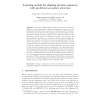Free Online Productivity Tools
i2Speak
i2Symbol
i2OCR
iTex2Img
iWeb2Print
iWeb2Shot
i2Type
iPdf2Split
iPdf2Merge
i2Bopomofo
i2Arabic
i2Style
i2Image
i2PDF
iLatex2Rtf
Sci2ools
RECOMB
2009
Springer
2009
Springer
Learning Models for Aligning Protein Sequences with Predicted Secondary Structure
Accurately aligning distant protein sequences is notoriously difficult. A recent approach to improving alignment accuracy is to use additional information such as predicted secondary structure. We introduce several new models for scoring alignments of protein sequences with predicted secondary structure, which use the predictions and their confidences to modify both the substitution and gap cost functions. We present efficient algorithms for computing optimal pairwise alignments under these models, all of which run in near-quadratic time. We also review an approach to learning the values of the parameters in these models called inverse alignment. We then evaluate the accuracy of these models by studying how well an optimal alignment under the model recovers known benchmark reference alignments. Our experiments show that using parameters learned by inverse alignment, these new secondarystructure-based models provide a significant improvement in alignment accuracy for distant sequences. ...
Alignment Accuracy | Computational Biology | Inverse Parametric Alignment | RECOMB 2009 | Sequence Alignment Model |
Related Content
| Added | 23 Nov 2009 |
| Updated | 23 Nov 2009 |
| Type | Conference |
| Year | 2009 |
| Where | RECOMB |
| Authors | Eagu Kim, Travis J. Wheeler, John D. Kececioglu |
Comments (0)

